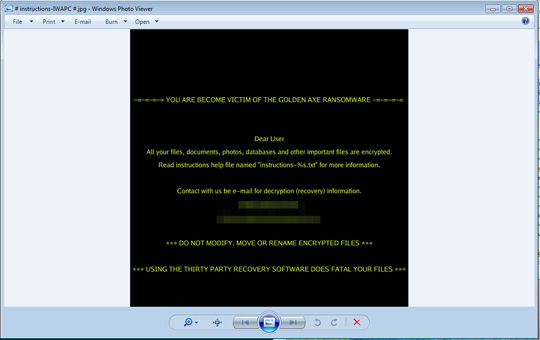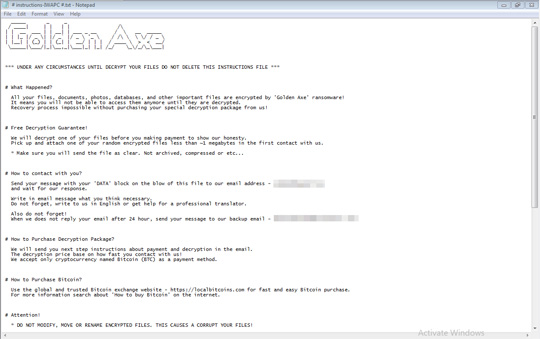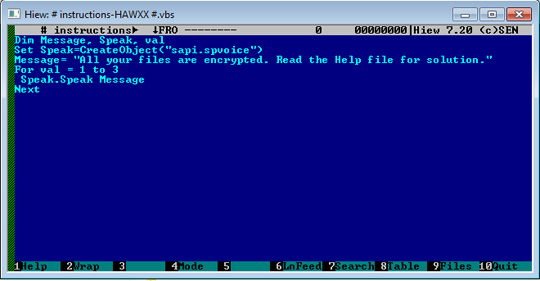Ransom.Win32.GOLDENAXE.THCAHAI
Trojan.Win32.DelShad.as(Kaspersky)
Windows


Threat Type: Ransomware
Destructiveness: No
Encrypted: Yes
In the wild: Yes
OVERVIEW
This Ransomware arrives on a system as a file dropped by other malware or as a file downloaded unknowingly by users when visiting malicious sites.
It encrypts files with specific file extensions. It drops files as ransom note.
TECHNICAL DETAILS
Arrival Details
This Ransomware arrives on a system as a file dropped by other malware or as a file downloaded unknowingly by users when visiting malicious sites.
Installation
This Ransomware adds the following processes:
- System}\cmd.exe /C vssadmin delete shadows /all /quiet;
- {System}\cmd.exe /C taskkill.exe /f /im sql*;
- {System}\cmd.exe /C taskkill.exe /f /im backup*;
- {System}\cmd.exe /C taskkill.exe /f /im anti*;
- {System}\cmd.exe /C taskkill.exe /f /im malware*;
- {System}\cmd.exe /C ping 127.0.0.1 -n 3 > NUL && del /Q /F "{Malware Path\Malware Name}.exe";
Other System Modifications
This Ransomware modifies the following registry entries:
HKEY_LOCAL_MACHINE\SOFTWARE\Microsoft\
SystemCertificates\AuthRoot\Certificates\
{certificate name} - modifies all certificates found
Blob = {hex value}
Ransomware Routine
This Ransomware encrypts files with the following extensions:
- .3dm
- .3ds
- .3fr
- .3g2
- .3gp
- .3pr
- .ab4
- .ach
- .acr
- .act
- .adb
- .ads
- .ait
- .apj
- .arw
- .asf
- .asm
- .asp
- .asx
- .avi
- .awg
- .bak
- .bay
- .bdb
- .bgt
- .bik
- .bin
- .bkf
- .bkp
- .bpw
- .cab
- .cdf
- .cdr
- .cdx
- .ce1
- .ce2
- .cer
- .cfp
- .cgm
- .chm
- .cib
- .cls
- .cmt
- .cnf
- .cpi
- .cpp
- .cr2
- .crt
- .crw
- .csh
- .csl
- .css
- .csv
- .dac
- .dat
- .db3
- .dbf
- .dbx
- .dc2
- .dcr
- .dcs
- .ddd
- .dds
- .der
- .des
- .dgc
- .dng
- .doc
- .dot
- .drf
- .drw
- .dtd
- .dwg
- .dxb
- .dxf
- .dxg
- .eml
- .eps
- .erf
- .exf
- .fdb
- .ffd
- .fff
- .fhd
- .fla
- .flv
- .fmb
- .fpx
- .fxg
- .gif
- .gry
- .hbk
- .hpp
- .htm
- .ibd
- .ibz
- .idx
- .iif
- .iiq
- .jar
- .jin
- .jpe
- .jpg
- .jse
- .jsp
- .kc2
- .kdc
- .key
- .log
- .lua
- .m4v
- .max
- .mdb
- .mdc
- .mdf
- .mef
- .mfw
- .mmw
- .mos
- .mov
- .mp3
- .mp4
- .mpg
- .mrw
- .msg
- .myd
- .ndd
- .nef
- .nk2
- .nop
- .nrw
- .ns2
- .ns3
- .ns4
- .nsd
- .nsf
- .nsg
- .nsh
- .nwb
- .nx2
- .nxl
- .nyf
- .oab
- .obj
- .odb
- .odc
- .odf
- .odg
- .odm
- .odp
- .ods
- .odt
- .oil
- .orf
- .ost
- .otg
- .oth
- .otp
- .ots
- .ott
- .p12
- .p7b
- .p7c
- .pab
- .pas
- .pat
- .pbl
- .pcd
- .pct
- .pdb
- .pdd
- .pef
- .pem
- .pfx
- .php
- .plc
- .png
- .pot
- .pps
- .ppt
- .prf
- .psd
- .pst
- .ptx
- .qba
- .qbb
- .qbm
- .qbr
- .qbw
- .qbx
- .qby
- .r3d
- .raf
- .rar
- .rat
- .raw
- .rdb
- .rtf
- .rw2
- .rwl
- .rwz
- .say
- .sd0
- .sda
- .sdf
- .sql
- .sr2
- .srf
- .srt
- .srw
- .st4
- .st5
- .st6
- .st7
- .st8
- .std
- .sti
- .stw
- .stx
- .svg
- .swf
- .sxc
- .sxd
- .sxg
- .sxi
- .sxm
- .sxw
- .tex
- .tga
- .thm
- .tif
- .tlg
- .txt
- .vbs
- .vmx
- .vob
- .war
- .wav
- .wb2
- .wmv
- .wpd
- .wps
- .x11
- .x3f
- .xis
- .xla
- .xlk
- .xlm
- .xlr
- .xls
- .xlt
- .xlw
- .xml
- .yuv
- .zip
It appends the following extension to the file name of the encrypted files:
- .{5 random letters}
It drops the following file(s) as ransom note:
- # instructions-{5 random letters}.png - drops in all folders encrypted

- # instructions-{5 random letters}.txt - drops in all folders encrypted

- # instructions-{5 random letters}.vbs - drops in all folders encrypted

SOLUTION
Step 1
Before doing any scans, Windows 7, Windows 8, Windows 8.1, and Windows 10 users must disable System Restore to allow full scanning of their computers.
Step 2
Note that not all files, folders, and registry keys and entries are installed on your computer during this malware's/spyware's/grayware's execution. This may be due to incomplete installation or other operating system conditions. If you do not find the same files/folders/registry information, please proceed to the next step.
Step 3
Restart in Safe Mode
Step 4
Restore this modified registry value
Important: Editing the Windows Registry incorrectly can lead to irreversible system malfunction. Please do this step only if you know how or you can ask assistance from your system administrator. Else, check this Microsoft article first before modifying your computer's registry.
- In HKEY_LOCAL_MACHINE\SOFTWARE\Microsoft\SystemCertificates\AuthRoot\Certificates\{certificate name} -- modifies all certicates found
- Blob = {default}
- Blob = {default}
Step 5
Search and delete these files
- # instructions-{5 random letters}.png - drops in all folders encrypted
- # instructions-{5 random letters}.txt - drops in all folders encrypted
- # instructions-{5 random letters}.vbs - drops in all folders encrypted
Step 6
Restart in normal mode and scan your computer with your Trend Micro product for files detected as Ransom.Win32.GOLDENAXE.THCAHAI. If the detected files have already been cleaned, deleted, or quarantined by your Trend Micro product, no further step is required. You may opt to simply delete the quarantined files. Please check this Knowledge Base page for more information.
Step 7
Restore encrypted files from backup.
Did this description help? Tell us how we did.

